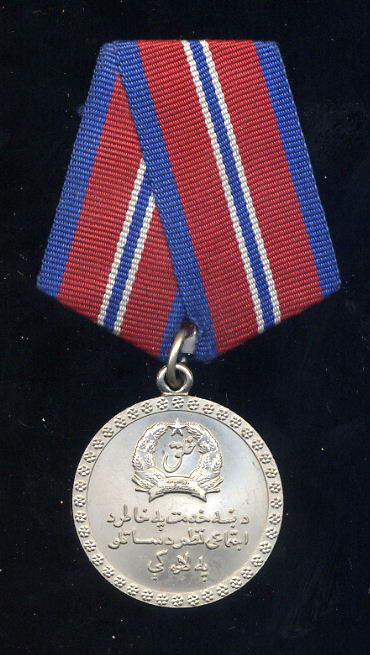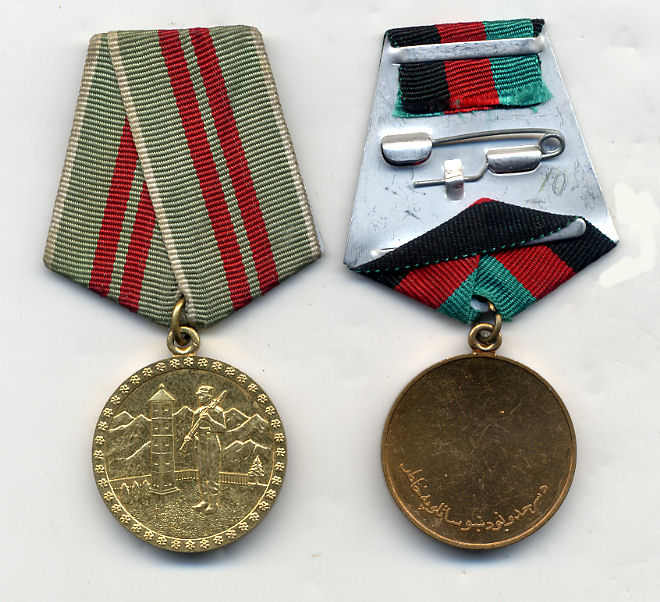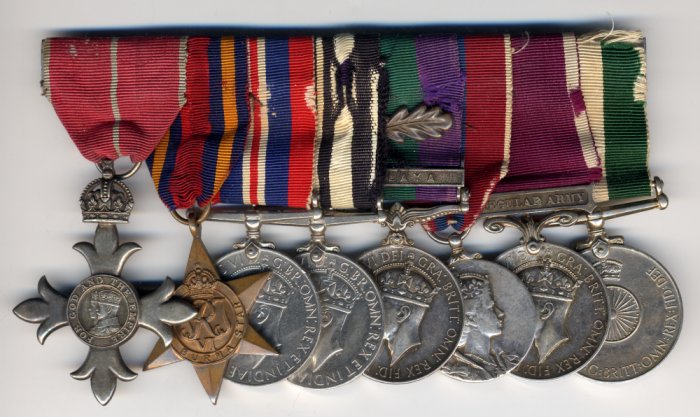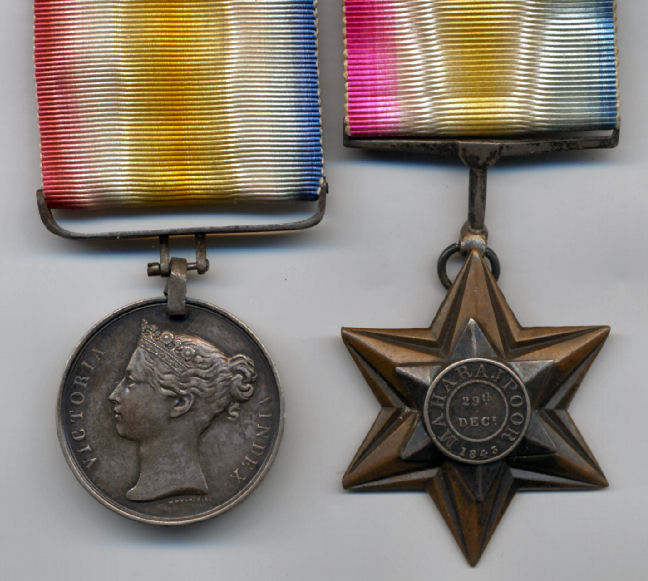-
Posts
14,343 -
Joined
-
Last visited
-
Days Won
25
Content Type
Profiles
Forums
Blogs
Gallery
Events
Store
Posts posted by Ed_Haynes
-
-
PDRA: Meritorious Public Service (???)
Honestly, I have no clue. The legend is something like what I have given above. I'd guess it is an Afghan parallel to the Soviet Medal for Distinguished Service in the Preservation of the Public Order.
Help???


 0
0 -
I have shown the pictures to Andreas Thies. He wrote:
"Das St?ck sieht auf dem Photo sehr gut aus und ist meiner ansicht nach ohne zweifel ein Original, deutscher Fertigung, ca. 1840-1860. Die deutschen GK sind wesentlich kleiner als die britischen. Es handelt sich mit h?chster Wahrscheinlichkeit um ein Gro?kreuz."
Red
Bahut accha. Is ke liye, mai aap ko shukriya bolte hai.
0 -
Female flying nurse who won the cross single-handedly piloting a zeppelin whilst performing a tricky operation? Maybe?
Nope. It would only interest Chris if the "tricky operation" were described in . . . well . . . er . . . uum . . . "full" detail.
0 -
Before these return to their usual home, a few more (at the risk of polluting with things that aren't German wound badges
 ).
).PDRA: Medal for Distinguished Frontier Service
Established 24 December 1980.
Awarded to members of the border forces and to civilians (especially frontier-based tribal leaders) for the protection of the frontier, bravery and the selflessness shown in operations with violators of the border, and for active assistance to the armies in protection Afghanistan's borders. The medal could be also awarded to foreign citizens.
Generally parallal to the Soviet border medal.
The correct ribbon is that shown on the left (obverse). The medal is, however, odten encountered on teh Afghan tricolor ribbon (right, reverse). Presumably, Soviet friends used whatever ribbon they could find?

 0
0 -
No, I have several proper groups this way. As a general pattern, it seems to reflect those who entered into shooting areas really late in their military careers or the war and were allowed to qualify for an area star without the usual first qualification for the 39-43 (or 39-45) star.
For example, the group to 388463 Major (QGO) Rukman Limbu, MBE, 1/7th Gurkha Rifles, that dwells with me, has but a single Burma Star and is very much on its original mounting (and period photos show him wearing this group). See: http://gmic.co.uk/index.php?showtopic=2331&st=33
0 -
Guess I have neglected to put this one up. Hard to categorize in my collection, as he's a "Gora Gorkha":
388463 Major (QGO) Rukman Limbu, MBE, 1/7th Gurkha Rifles
enlisted 4 December 1925, Quetta
Lance/Naik 1932
Naik September 1938
Subadar-Major after 1948
1954 MBE
retired on pension 1955, Major (QGO)
died 30 December 1975
1- The Most Excellent Order of the British Empire, 2nd type, member
2- Burma Star - unnamed
3- The War Medal, 1939-45 - unnamed
4- The India Service Medal, 1939-45 - unnamed
5- The General Service Medal, 1918-64, George VI (4th obverse, 1949-52) - MALAYA, MiD leaf - MAJOR. RUKMAN LIMBU. 7 G.R.
6- Elizabeth II Coronation Medal, 1953 - unnamed (he was senior GCO of 7 GR in GR Contingent at London for the coronation)
7- Army Long Service and Good Conduct Medal. George VI, 2nd type - REGULAR ARMY - 388463 CAPT. (KGO). RUKUMAN LIMBU. 7 G.R.
8- The Indian Independence Medal, 1947 - 388463 SUB BAM RUKMAN LIMBU. G.R.
The medals are as worn, complete with the most odd "singleton" Burma Star and no 1939-45 Star.


 0
0 -
Thanks for the thread, Sam! As you know it is an area where I have an interest and know NOTHING. More more more.
As eye-candy:
Private John Maxham, H. M. 40th Regiment
1- Candahar, Ghuznee, Cabul - Private John Maxham H. M. 40th Regt.
2- Maharajpoor Star - Private John Maxham H. M. 40th Regt.
"Paperwork" in hand. Full Diana Birch research job from the 1970s.

In summary:
Born Hansted, Suffolk, about 1807. A labourer, he enlisted in the 40th Regiment of Foot at Cochester on 21 November 1825, aged 18 years. He served 19 years and 74 days, 16 8/12 years overseas:
New South Wales and Van Diemen?s Land ? 1 year 11 months
East Indies ? 10 years 10 months
Scinde, Baluchistan, Afghanistan ? 3 years 11 months
Shown as qualified for both medals. No courts martial and conduct shown as ?good?. Discharged 1 February 1845 on account of health, he signed with an ?X?.
See also: http://gmic.co.uk/index.php?showtopic=2400&st=56


 0
0 -
Department of Transportation 9/11 Medal
The 9-11 Medal is a special decoration of the U.S. Department of Transportation which was first created in 2002. The decoration recognizes those civilians and members of the military who performed heroic deeds and valorous accomplishments in the immediate aftermath of the September 11, 2001 attacks on the United States of America.
The 9-11 Medal is not a simple service decoration, but rather recognizes individual acts of bravery that resulted in the saving of life or great assistance to the rescue efforts from the September 11th attacks. A separate military decoration, the 9-11 Ribbon, is presented to members of the U.S. military for general aide and assistance to the victims of the September 11th attacks.
The 9-11 Medal is a one time decoration and is authorized for wear by both civilians and members of the U.S military.
Obverse:
When was this shifted to a normal suspension-medal? The original design had a large (obscenely large, some may say) medal of this design suspended from a neck ribbon. Really tacky.
While this cannot be called a lovely medal, they have surely improved it.
0 -
-
Way WAY outside my interests, but I have always been curious. Is their any easy way to tell German Guelph badges from British Guelph badges? (Other than the hallmarks, of course.)
0 -
Actually, he was just kidding us . . . .
 0
0 -
Depends on the rules of the country of the wearer. In the Netherlands you wear your own countries awards first. Highest to lowest.
Next are the foreign countries alphabetically according to the French names of the countries. If you have more then one award from a foreign country then you wear them also from the highest to the lowest award.
I believe this is the case in most European countries?
I all countries, I assume, you'd wear your own awards first. British practice, the only one I know for sure, is to then wear foreign awards (if sanctioned) in the order of award.
Such rules are, of course, often ignored.
0 -
If this is the second row of a group mounted alphabetically according to the French names of the countries, why is Austria ( Autriche ) in the second row?
An interesting point, but shouldn't things be mounted in the order of award?
0 -
Yes, this is increasingly looking like either a seriously jumbled group or a made-up group. Unless it is the second row of something longer.
But NOT to "a german member of the ministry of farming and forest".
0 -
For India "I", the only ones I have.
0 -
I'm fairly certain that these were no longer to be worn after 1922.
They were certainly used in WWII. Cannot say beyond that.
0 -
Worn vertically, lower left sleeve
Yes, and this is why they weren't worn in forces where the uniform included no lower left sleeve.
0 -
Thanks Ed, I forgott to mention the languaga database, as it is of VERY big issua as most of the books dealing with those exotic countrys are written in their own language.
regards
Milan
For any country, the most (only?) reliable sources are those in the language of the country involved. This is not especially surprising.
0 -
Well treated, in so far as any reliable information is available, in a forthcoming book on Indian medals.
 0
0 -
Is is also important that the project coordinator/editor (Eric? he suggested it??) get a group of people together who have the requisite language skills and access to sources (not to sorts of guesses that just pollute our knowledge). This may "break" the whole project?
0 -
* * * * *
Hmmmm ...
Who among us has a Ph.D. in history and has already been published and is a well-known whip-swinger?

Inquiring minds and all that.
Chuck
Shaddup.
0 -
And poor little Mongolia had to invent something special and unique, just for Him!!
0 -
Which one is fake?
Easy: The one not in your collection.
 0
0 -
Good ideas, Rick. But, maybe, the first question will be "what is the table of contents"? What is in, what is out. USSR out, OK. What about republics within the USSR and post-Soviet successor states (e.g., Estonia, Georgia)?
Warsaw Pact? That's be (excluding USSR): East Germany, Czechoslovakia, Bulgaria, Hungary, Poland, Romania, and Albania (for a while).
Or - maybe better, but!? -- COMECON: (also excluding USSR) Bulgaria, Czechoslovakia, the German Democratic Republic, Hungary, Romania, Poland, Cuba, Mongolia, and Vietnam.
Add Yugoslavia?
Or . . . ????
(These sorts of questions are the sorts of things I have had to deal with in my 1200+ page "work in progress" on Arab ODM.)
0





Ed's Afghan Abyss
in South Asia
Posted
PDRA: Unknown
Totally unknown. Help? Anyone??